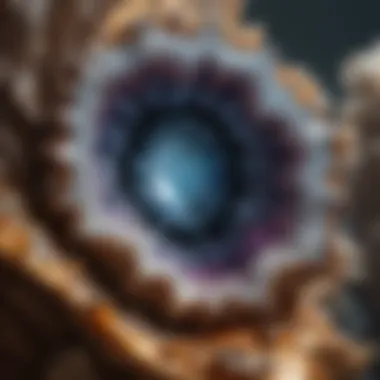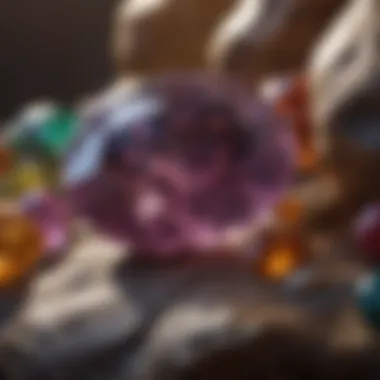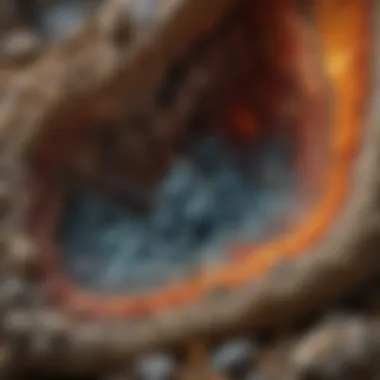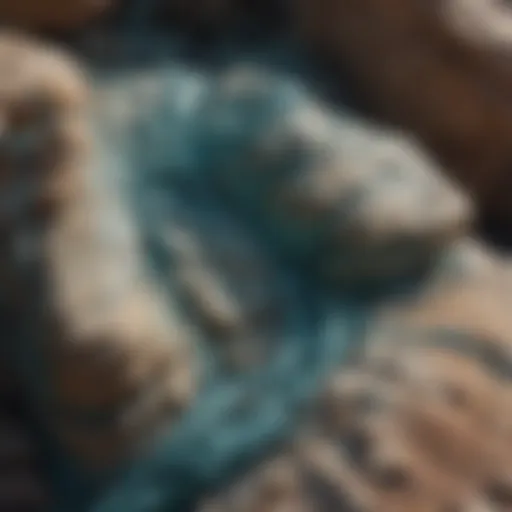Unlocking the Mysteries of Rocks and Gems: An Expert Guide for Enthusiasts


Rock and Fossil Indetification
In the vast world of rocks and gems, one of the foundational aspects for enthusiasts is the ability to identify different types of rocks and fossils. Understanding the unique characteristics of each specimen is essential to truly appreciate the Earth's geological wonders. When delving into this captivating realm, one must pay close attention to details that distinguish various rocks and fossils from one another. Among the key elements to observe are the textures, color hues, and structural patterns embedded within these treasures. Tools play a crucial role in the identification process, aiding enthusiasts in discerning the subtle differences that set each rock and fossil apart. From magnifying glasses to specialized kits, having the right tools at hand can enhance the accuracy of identification, allowing collectors to expand their knowledge and appreciation for these natural marvels.
Collecting Tips and Techniques
For passionate rock and fossil collectors, mastering the art of collecting goes beyond just gathering specimens—it involves a deep understanding of best practices and techniques. To embark on a successful collecting journey, enthusiasts must first familiarize themselves with the optimal methods for gathering rocks and fossils. Locating prime collecting sites is key, as different geological regions offer unique opportunities to uncover rare and precious specimens. Whether exploring rocky terrains or excavating in designated fossil sites, knowing where to search can significantly enhance the collection experience. Safety is paramount when extracting specimens, with proper tools and techniques essential to avoid damage to both the specimens and oneself. By incorporating safe and efficient extraction methods, collectors can acquire treasures while respecting the delicate nature of geological finds.
Preservation and Display
Preservation is a critical aspect of rock and fossil collecting, ensuring that specimens retain their beauty and integrity over time. Various techniques can be employed to preserve these geological wonders, ranging from protective coatings to controlled environments. Proper storage methods are equally important to prevent deterioration and safeguard specimens for future generations. Apart from preservation, display plays a vital role in showcasing the splendor of rocks and fossils. Enthusiasts can get creative with display ideas, crafting unique arrangements that highlight the aesthetic appeal and educational value of their collections. By thoughtfully preserving and displaying rocks and fossils, collectors can share their passion with others while maintaining the authenticity and allure of these natural treasures.
Geological Insights
Delving into the geological insights offered by rocks and fossils unveils a world rich with history and significance. Understanding the geological formations and processes that shaped these specimens provides a deeper appreciation for their beauty and diversity. Each rock and fossil carries a unique story, reflecting the intricate processes that occurred over millions of years. Exploring the historical significance of rocks and fossils further illuminates their value, offering insights into the Earth's evolution and past environments. Notable discoveries in the field continue to broaden our understanding of geology, uncovering new insights and expanding the boundaries of scientific knowledge. By embracing the geological insights provided by rocks and fossils, enthusiasts can connect with the Earth's past and marvel at the wonders that lie beneath its surface.
Introduction to the World of Rocks and Gems
The exploration of the world of rocks and gems holds immense significance for enthusiasts interested in geological wonders. This section serves as a gateway into a realm where nature's beauty and mysteries converge, offering a journey into the depths of Earth's ancient treasures. By delving into the geological composition and formations of rocks and gems, individuals can unravel the narrative written in stone and crystal over millennia.
The Intriguing Allure of Rocks and Gems
Exploring the Geological Origins
The exploration of the geological origins of rocks and gems unveils a chronicle of Earth's dynamic history. Delving into the depths of the planet's crust, enthusiasts can trace the metamorphic, igneous, and sedimentary processes that have shaped these captivating formations. Understanding these geological origins not only provides insights into the forces that have sculpted our planet but also offers a deeper appreciation for the intricate beauty locked within each rock and gem.
Understanding the Formation Processes
The exploration of the formation processes of rocks and gems unravels the intricate mechanisms behind the creation of these geological marvels. From the intense heat and pressure that give rise to metamorphic rocks to the gradual deposition and compaction leading to sedimentary formations, each process encapsulates a unique chapter in Earth's geological story. By understanding these formation processes, enthusiasts can gain a profound insight into the conditions and events that have led to the existence of these priceless treasures.
Significance of Rock and Gem Collecting


Cultural and Historical Perspectives
Rock and gem collecting transcends mere hobbyist interests, delving into cultural and historical contexts that span civilizations and epochs. Through the lens of cultural and historical perspectives, collectors can explore how societies have revered and utilized rocks and gems throughout history. By unearthing the symbolic meanings and practices associated with these geological specimens, enthusiasts can forge connections with the legacy of human civilization embedded in every rock and gem.
Scientific and Educational Value
Beyond their aesthetic allure, rocks and gems hold immense scientific and educational value that enriches the collector's experience. By studying the mineral compositions, geological structures, and formation processes of rocks and gems, collectors can engage in a profound scientific exploration of Earth's geology. This scientific knowledge not only deepens one's understanding of the natural world but also opens doors to educational opportunities in geology, mineralogy, and gemology.
Rock Collecting: Unveiling Earth's Ancient Treasures
Rock collecting serves as a gateway to unearth Earth's ancient wonders, offering enthusiasts a profound connection to our planet's history and geology. In this comprehensive guide to exploring rocks and gems, the section on rock collecting delves into the significance of understanding the different types of rocks and minerals that shape our world. By studying igneous, sedimentary, and metamorphic rocks, collectors gain insights into the diverse processes that have sculpted our Earth over millennia, providing a unique perspective on our planet's evolution.
Types of Rocks and Minerals
Igneous, Sedimentary, and Metamorphic Rocks
One of the foundational aspects of geology, igneous, sedimentary, and metamorphic rocks play a vital role in understanding the Earth's geological history. Igneous rocks, formed from molten magma, showcase the fiery origins of our planet, with their crystalline structures revealing the intense heat and pressure they have endured. On the other hand, sedimentary rocks offer a glimpse into ancient environments through the layers of sediment compacted over time. Metamorphic rocks, transformed by immense heat and pressure, showcase the dynamic processes that continue to shape our planet. Each type of rock brings a unique perspective to rock collectors, enriching their understanding of Earth's complex geology.
Common Minerals and Crystals
In addition to rocks, minerals and crystals add a layer of fascination to rock collecting. Common minerals such as quartz, feldspar, and calcite offer a dazzling array of colors and properties, each telling a story of geological processes in which they are formed. Crystals, with their symmetrical structures and distinct cleavage properties, captivate collectors with their unique formations. Understanding common minerals and crystals enhances collectors' ability to identify and appreciate the diverse components of the Earth's crust, providing insight into the natural treasures hidden beneath the surface.
Tools and Techniques for Rock Collectors
Rock Hammers and Chisels
Integral to any rock collector's toolkit, rock hammers and chisels are essential for extracting samples from rocky outcrops. The sturdy construction of rock hammers allows for precise strikes, facilitating the collection of specimens without damaging their integrity. Chisels, with their sharp edges, aid in splitting rocks to reveal hidden mineral formations, enhancing the collector's ability to access different layers of rock for examination. These tools, when used skillfully, provide collectors with a hands-on approach to exploring the geological wonders of our planet.
Identification Methods and Resources
Identifying rocks and minerals is a crucial skill for any collector, and employing the right methods and resources can elevate the experience. Visual inspections, streak tests, and specific gravity measurements are among the techniques used to differentiate minerals based on their physical properties. Specialized tools such as loupes and ultraviolet lamps enable collectors to analyze samples more closely, revealing unique characteristics that aid in identification. By combining traditional observation techniques with modern resources, collectors can enhance their ability to distinguish between various rock and mineral specimens, enriching their collecting experience.
Exploring the World of Gemstones


Exploring the World of Gemstones within this article holds significant importance as it delves into the mesmerizing universe of rocks and gems. This section aims to enlighten enthusiasts about the diverse array of gemstone varieties, providing valuable insights into their rarity, value, and aesthetic appeal. By exploring gemstones, readers can expand their knowledge of Earth's geological wonders and appreciate the intricate beauty these natural treasures possess.
Dazzling Diversity of Gemstone Varieties
Precious and Semi-Precious Gems
Delving into the realm of Precious and Semi-Precious Gems unveils a captivating aspect of the gemstone world. These gems contribute extensively to the overall topic by showcasing a unique blend of rarity and allure. The key characteristic of Precious and Semi-Precious Gems lies in their exquisite colors, clarity, and durability, making them a popular choice for collectors and jewelry enthusiasts alike. The unique feature of these gems is their intrinsic value, with each stone carrying its enchanting characteristics that add a touch of elegance to any collection. Despite their desirability, Precious and Semi-Precious Gems may have certain disadvantages such as being more susceptible to damage or requiring specialized care, elevating their significance in this article.
Rarity and Value Factors
The exploration of Rarity and Value Factors contributes significantly to unraveling the allure of gemstones. Understanding the rarity and value aspects adds depth to the appreciation of gemstone varieties. The key characteristic highlighted in this aspect is the exclusivity of certain gemstones, intertwined with their historical significance and market demand. Rarity and Value Factors stand out as a beneficial choice for this article due to their integral role in determining a gemstone's worth and desirability. The unique feature lies in the interplay between scarcity and demand, influencing the gemstone market and collector preferences. While these factors enhance the allure of gemstones, they also pose challenges in terms of accessibility and pricing, adding layers of complexity to the gemstone world.
Popular Gemstone Cuts and Settings
Exploring Popular Gemstone Cuts and Settings unveils the creative facets of gemstone craftsmanship, enriching the overall narrative with insights into jewelry design and aesthetics. By examining the art of cutting and setting gemstones, readers can appreciate the skilled workmanship behind each piece and how different styles enhance a gemstone's beauty and appeal.
Faceted, Cabochon, and Mixed Cuts
The discussion on Faceted, Cabochon, and Mixed Cuts brings forth the intricate world of gemstone cutting techniques. These cuts contribute to the overall topic by showcasing the diverse ways in which gemstones can be shaped and polished to enhance their brilliance and visual appeal. The key characteristic revolves around the precision and technique required for each cut, reflecting the skill and artistry of lapidaries. These cuts are a popular choice for this article due to their ability to transform a gemstone into a dazzling masterpiece, each cut presenting its unique play of light and color. The unique feature of these cuts lies in their versatility, catering to different preferences and styles in jewelry design, although certain cuts may have advantages or disadvantages based on the gemstone's properties.
Setting Styles and Jewelry Design
Exploring Setting Styles and Jewelry Design sheds light on the art of showcasing gemstones in various settings to create stunning pieces of adornment. This aspect contributes creatively to the article by elucidating how different settings can enhance a gemstone's beauty and express individuality in jewelry design.
The key characteristic emphasized here is the harmonious blend of metalwork and gemstones, creating a synergy that elevates the overall aesthetic appeal of the jewelry piece. Setting Styles and Jewelry Design stand out as a beneficial choice for this article due to their pivotal role in presenting gemstones in a wearable and expressive manner. The unique feature lies in the range of setting styles available, from classic prong settings to modern bezel or pavé settings, each offering a distinct aesthetic experience. While these settings enhance the visual impact of gemstones, they also require careful consideration to ensure durability and aesthetic balance, showcasing the craftsmanship and creativity behind each piece of gemstone jewelry.
The Art of Gemstone Identification
Gemstone identification plays a pivotal role in the realm of rocks and gems, serving as a fundamental skill for enthusiasts and collectors. Understanding the distinct characteristics and properties of each gemstone is essential in determining its value, rarity, and authenticity. Through the art of gemstone identification, individuals can unlock the secrets held within each precious stone, enhancing their knowledge and appreciation of these geological marvels.
Characteristics and Properties
Color, Clarity, and Cut


Color, clarity, and cut are crucial factors in gemstone assessment, affecting both the aesthetic appeal and intrinsic value of a gem. The color of a gemstone is determined by various elements present within the stone, influencing its overall beauty and rarity. Clarity, on the other hand, refers to the presence of inclusions or flaws within the gem, impacting its transparency and brilliance. The cut of a gemstone encompasses its shape and faceting, enhancing its sparkle and fire. Understanding the significance of color, clarity, and cut is imperative for gemstone identification, enabling collectors to differentiate between various gem types and grades.
Hardness and Refractive Index
Hardness and refractive index are vital properties that aid in identifying gemstones and assessing their durability and optical properties. The hardness of a gemstone, measured on the Mohs scale, indicates its resistance to scratches and wear, helping individuals determine the suitability of a gem for particular uses. The refractive index of a gemstone measures the speed of light as it travels through the stone, influencing its brilliance and dispersion of colors. By examining the hardness and refractive index of gemstones, collectors can make informed decisions regarding gem care, jewelry design, and gemstone combinations.
Testing and Verification Methods
Visual Inspections
Visual inspections are essential in the preliminary assessment of gemstones, allowing collectors to observe key characteristics such as color saturation, clarity levels, and surface features. The naked eye can detect major flaws, inclusions, or color zoning in a gemstone, providing valuable insights into its quality and authenticity. Visual inspections serve as the first step in gemstone evaluation, guiding collectors towards more detailed testing methods for conclusive identification.
Specialized Gemological Tests
Specialized gemological tests utilize advanced equipment and techniques to analyze unique properties of gemstones, such as specific gravity, refractive index measurement, and spectroscopy. These tests offer quantitative data on a gemstone's composition, origin, and treatment history, aiding in accurate identification and valuation. By utilizing specialized gemological tests, collectors can unravel the intricate details of each gemstone, enhancing their expertise and collection portfolio.
Preserving and Displaying Your Rock and Gem Collection (at least 300- words):
Preserving and Displaying Your Rock and Gem Collection is a critical aspect of this comprehensive guide to exploring rocks and gems. It plays a pivotal role in not only maintaining the integrity of your collection but also showcasing it in all its glory. Proper preservation ensures that your precious rocks and gems retain their value and aesthetic appeal for generations to come. Displaying them with care adds a touch of elegance to your living space, turning your collection into a conversation starter and a thing of beauty.
Storage and Conservation Strategies (at least 250- words):
Avoiding Moisture and Light Damage:
Avoiding Moisture and Light Damage is imperative when it comes to preserving the quality and longevity of your rock and gem collection. Moisture can lead to erosion and degradation of certain specimens, while exposure to light might cause colors to fade or surfaces to deteriorate. By implementing strategies to minimize moisture and light exposure, you safeguard your collection's pristine condition and ensure it remains visually stunning over time.
Organizing and Cataloging Techniques:
Organizing and cataloging techniques are essential for efficiently managing and documenting your rock and gem collection. Proper organization not only makes it easier to locate specific specimens but also helps in tracking their provenance, historical significance, and any scientific data associated with them. By employing systematic cataloging methods, you can enhance the value of your collection and create a valuable resource for both personal enjoyment and potential research endeavors.
Showcasing Your Treasures (at least 250- words):
Display Cases and Lighting:
Display cases and lighting are integral components of effectively showcasing your rock and gem collection. A well-designed display case not only protects your treasures from dust and physical damage but also provides a visually appealing backdrop that accentuates their beauty. Strategic lighting enhances the colors and textures of your specimens, creating a captivating display that draws admiration and appreciation. By investing in quality display cases and lighting fixtures, you elevate the presentation of your collection to museum-quality standards.
Creating a Visual Showcase:
Creating a visual showcase is an art form that allows you to curate your rock and gem collection in a compelling and aesthetically pleasing manner. By arranging specimens based on complementary colors, shapes, and sizes, you can create visually stunning displays that are both engaging and educational. Incorporating creative elements such as background backdrops, informational plaques, and interactive components further enriches the showcase experience, transforming it into a dynamic journey of exploration and discovery.







